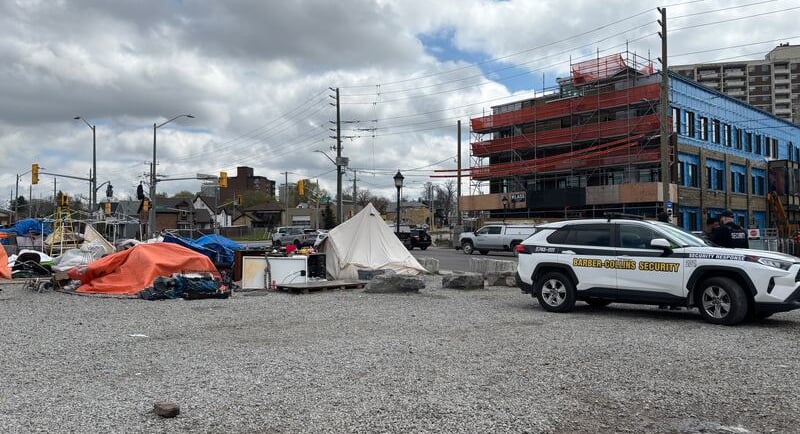Overdose Death at 100 Vic St. Highlights Dangers of Encampment Evictions in Waterloo
The Waterloo Region's decision to barricade the 100 Victoria Street homeless encampment for a Metrolinx expansion led to a preventable overdose death, sparking public outrage and calls for accountability. Advocates warn that sealing off support networks and emergency access puts more lives at risk.
Katherine Amal Al Zanoun
6/15/20253 min read


In a controversial and tragic turn of events, the Region recently passed a bylaw enabling the city to erect physical barricades around the homeless encampment at 100 Victoria Street, sealing it off with large dumpsters and patrolled security. This action came after the Region signed a deal with Metrolinx, giving the transportation agency rights to use the land for an upcoming expansion project.
But this decision has already proven deadly.
The Incident: A Preventable Overdose Death
On Thursday, May 1st, a resident of the Victoria Street encampment suffered a drug overdose. Paramedics were called to the scene, but the newly installed barricades—dumpsters and a security vehicle typically parked across the street—prevented quick access. The ambulance was forced to find alternate ways in, costing critical minutes. The man tragically died before emergency responders could reach him.
The Waterloo Region Community Legal Services (WRCLS), who had previously advocated for this individual, responded publicly, confirming that while paramedics did eventually make it into the encampment, they were not fast enough to save his life. The organization stated plainly: this death could have been prevented if the region had not chosen to barricade the camp.
“This was not just a delay—it was a lethal obstruction,” said a WRCLS representative.
The Council's Role and the Metrolinx Agreement
This tragedy stems directly from a new bylaw passed by City Council earlier this month, aimed at “reclaiming public land for infrastructural development.” The bylaw paved the way for a deal with Metrolinx, which plans to use the land for the expansion of a nearby transportation facility—an infrastructure project touted by officials as essential for growth.
However, critics argue the move was rushed, secretive, and made without any public consultation or meaningful alternatives for the roughly 30 encampment residents who would be displaced.
“There was no housing plan, no safety net—just a decision to disappear people,” said Councillor Elena Javid, one of the few to oppose the bylaw. “And now someone has died because of it.”
Public Backlash and Outrage
The overdose death has ignited public outcry. Community members, harm reduction advocates, and housing activists have mobilized swiftly, organizing vigils and demanding accountability.
“This death is the result of policy violence,” said Kendra Singh, a local outreach worker. “We warned them. We begged them not to do this.”
The Canadian Harm Reduction Network issued a strong statement condemning the region’s actions, calling the barricade “a public health and human rights failure.”
What’s Happening Now
Despite public pressure, the barricades remain. Private security continues to patrol the perimeter, and access to the site is still restricted. Outreach workers, medical staff, and community members are often denied entry or forced to wait—an unacceptable barrier when working with people in crisis.
The Region has defended its actions, stating that “shelter options are available,” but those on the ground paint a different picture: shelters are full, unsafe, or far removed from the support networks and stability the encampment once provided.
This is untrue as a former worker for the WRCLS Shannon Down states that “while the number of homeless people in our region exceeds the number of shelter beds by a factor of four to five, and it’s getting worse, then the reality is that there are going to be encampments around for a long time” [2]
Impact on Encampment Residents and Support Workers
The consequences of this barricade extend far beyond one tragic death. Encampment residents now live in even greater fear—cut off from harm reduction services, medical care, food deliveries, and the outreach teams they rely on. With limited emergency access and increasing pressure from authorities, life in the encampment has grown more dangerous and isolating.
“This isn’t just neglect. It's an active harm,” said Samira Begum, a street nurse who regularly visited 100 Vic St. “We’ve been cut off from the people we serve. And they’ve been cut off from life-saving help.”
